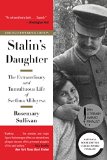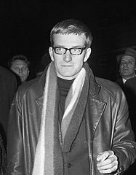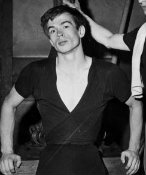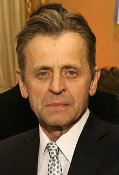Summary | Excerpt | Reviews | Beyond the Book | Read-Alikes | Genres & Themes | Author Bio

Critics' Opinion:
Readers' Opinion:
First Published:
Jun 2015, 752 pages
Paperback:
Jun 2016, 768 pages
 Book Reviewed by:
Book Reviewed by:
Sinéad Fitzgibbon
Buy This Book
This article relates to Stalin's Daughter
When Svetlana Alliluyeva, Joseph's Stalin's only daughter, took the impulsive decision on 6 March, 1967, to enter the American Embassy in New Delhi and request political asylum, she took the world by surprise. Becoming an instant celebrity, she was feted in the United States (her adopted country), and was widely reported on in the world's press. Understandably the reaction in her homeland was somewhat less enthusiastic. Given the cachet her family history carried, and the elevated status she enjoyed in the Soviet Union as a result, Alliluyeva's defection rocked the USSR to its very core. Keen to limit the damage, the Soviet government and the KGB worked hard to discredit Svetlana, orchestrating an insidiously negative propaganda campaign, branding her mentally and emotionally unstable.
Svetlana's was not the only high-profile defection to the West during the Cold War years (1947 – 1991). When the Iron Curtain was drawn across Europe in the aftermath of the Second World War, newly enshrined emigration bans designed to stem the flood of migrants to the more prosperous West meant that those living in Eastern Bloc countries were now completely cut off from the rest of the world. Even though life in post-war, post-Stalinist Communist Russia, and its satellite states, was less difficult than during the Stalin years, it was still trying by anyone's standards. Economically challenged and suffering from the long-term negative effects of collectivization and a clunky, overly bureaucratic administration, the Soviet Union had little to offer its citizens – opportunities for self-improvement were few and poverty was widespread. Strict state censorship, which forbade any criticism of the Soviet system, made life particularly intolerable for the intelligentsia, with many writers, artists and scientists falling foul to draconian state-sponsored suppression. Little wonder then, that some were prepared to risk their lives in an attempt to escape to the free West.
Alliluyeva's defection was a spur-of-the-moment decision, taken when a bureaucratic oversight meant that she was in possession of her passport for a short time during her first-ever trip overseas to India (it was procedure to confiscate the passports of Soviet citizens on the rare occasions they were permitted to travel abroad, in order to make defections all the more difficult). Many defections were carried out in similarly opportunistic ways – deserters simply took advantage if an opportunity presented itself. This accounts for the disproportionately high number of defections among chess players; given their dominance in the game (thanks in large part to state-sponsored chess schools), the Soviets acquiesced to overseas tours as a means of promoting Soviet dominance and cultural superiority on the world stage. Evading handlers while already in the West was a much easier prospect than effecting an escape from within the Soviet Union.
 Representatives from the Soviet arts world also swelled the ranks of defectors for much the same reason. The pianist and conductor, Maxim Shostakovich (son of the internationally acclaimed composer, Dmitri Shostakovich) took flight in 1981 during a tour of West Germany, six years after his renowned father's death.
Representatives from the Soviet arts world also swelled the ranks of defectors for much the same reason. The pianist and conductor, Maxim Shostakovich (son of the internationally acclaimed composer, Dmitri Shostakovich) took flight in 1981 during a tour of West Germany, six years after his renowned father's death.
But by far the most famous artist-defectors were from the world of ballet. The astonishing athleticism and exotic good looks of the male ballet dancers in particular captured the world's imagination.
 The most notable of these were Rudolf Nureyev and Mikhail Baryshnikov. Nureyev escaped the Soviet net during the Parisian leg of the Kirov Ballet's European tour in 1961, aided by the French police and a socialite friend called Clara Saint. Nureyev would go on to enjoy a stellar career on the international ballet stage, most notably partnering with Margot Fonteyn, the Royal Ballet's prima ballerina, in London's Covent Garden for many years.
The most notable of these were Rudolf Nureyev and Mikhail Baryshnikov. Nureyev escaped the Soviet net during the Parisian leg of the Kirov Ballet's European tour in 1961, aided by the French police and a socialite friend called Clara Saint. Nureyev would go on to enjoy a stellar career on the international ballet stage, most notably partnering with Margot Fonteyn, the Royal Ballet's prima ballerina, in London's Covent Garden for many years.
 Mikhail Baryshnikov, arguably the most notable ballet dancer to defect after Nureyev, followed a similar path to his predecessor. "Misha," as he is often known, took advantage of the Kirov's tour of Canada in 1970, requesting political asylum in Toronto. He would later move to the United States, dancing for the American Ballet Theatre, an institution of which he later became artistic director. He became a naturalized citizen of the United States in 1986.
Mikhail Baryshnikov, arguably the most notable ballet dancer to defect after Nureyev, followed a similar path to his predecessor. "Misha," as he is often known, took advantage of the Kirov's tour of Canada in 1970, requesting political asylum in Toronto. He would later move to the United States, dancing for the American Ballet Theatre, an institution of which he later became artistic director. He became a naturalized citizen of the United States in 1986.
The rate of Soviet defections slowed in the 1980s, during the period of Mikhail Gorbachev's program of perestroika (restructuring) and glasnost (openness) which lessened the onerous restrictions on Soviet citizens. The fall of the Berlin Wall in 1989 was the death knell for the Soviet Union, which broke up in 1991. Even though the Cold War is now receding into the annals of history, it will never be forgotten. In much the same way, the courage and determination of Alliluyeva, Shostakovich, Nureyev, Baryshnikov, and their fellow defectors, will live on as a reminder of the importance of enduring human determination in the face of oppression.
Picture of Maxim Shostakovich from Dutch National Archives
Picture of Rudolf Nureyev from Pressens Bild / Scanpix
Picture of Mikhail Baryshnikov from Miew En
Filed under People, Eras & Events
![]() This "beyond the book article" relates to Stalin's Daughter. It originally ran in July 2015 and has been updated for the
June 2016 paperback edition.
Go to magazine.
This "beyond the book article" relates to Stalin's Daughter. It originally ran in July 2015 and has been updated for the
June 2016 paperback edition.
Go to magazine.





The House on Biscayne Bay
by Chanel Cleeton
As death stalks a gothic mansion in Miami, the lives of two women intertwine as the past and present collide.

The Flower Sisters
by Michelle Collins Anderson
From the new Fannie Flagg of the Ozarks, a richly-woven story of family, forgiveness, and reinvention.

The Funeral Cryer by Wenyan Lu
Debut novelist Wenyan Lu brings us this witty yet profound story about one woman's midlife reawakening in contemporary rural China.
Your guide toexceptional books
BookBrowse seeks out and recommends the best in contemporary fiction and nonfiction—books that not only engage and entertain but also deepen our understanding of ourselves and the world around us.